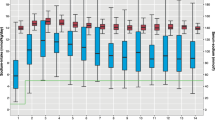Abstract
Objective:
Determine the incidence of refeeding syndrome, defined by the presence of hypophosphatemia in very-low-birth-weight (VLBW) infants with intrauterine growth restriction (IUGR) compared with those without IUGR.
Study design:
In this retrospective cohort study, VLBW infants admitted over a 10-year period (271 IUGR and 1982 non-IUGR) were evaluated for specific electrolyte abnormalities in the first postnatal week.
Result:
IUGR infants were significantly more likely to have hypophosphatemia (41% vs 8.9%, relative risk (95% confidence interval: 7.25 (5.45, 9.65)) and severe hypophosphatemia (11.4% vs 1%, 12.06 (6.82, 21.33)) in the first postnatal week. The incidence of hypophosphatemia was significantly associated with the presence of maternal preeclampsia in all VLBW infants (odds ratio (OR): 2.58 (1.96, 3.40)) when controlling for birth weight and gestational age.
Conclusion:
Refeeding syndrome occurs in VLBW infants with IUGR and born to mothers with preeclampsia. Close monitoring of electrolytes, especially phosphorus, is warranted in this population.
This is a preview of subscription content, access via your institution
Access options
Subscribe to this journal
Receive 12 print issues and online access
$259.00 per year
only $21.58 per issue
Buy this article
- Purchase on Springer Link
- Instant access to full article PDF
Prices may be subject to local taxes which are calculated during checkout

Similar content being viewed by others
References
Barker DJ . The developmental origins of adult disease. J Am Coll Nutr 2004; 23: 588S–595SS.
Boateng AA, Sriram K, Meguid MM, Crook M . Refeeding syndrome: treatment considerations based on collective analysis of literature case reports. Nutrition 2010; 26: 156–167.
Skipper A . Refeeding syndrome or refeeding hypophosphatemia: a systematic review of cases. Nutr Clin Pract 2012; 27: 34–40.
Patel U, Sriram K . Acute respiratory failure due to refeeding syndrome and hypophosphatemia induced by hypocaloric enteral nutrition. Nutrition 2009; 25: 364–367.
Byrnes MC, Stangenes J . Refeeding in the ICU: an adult and pediatric problem. Curr Opin Clin Nutr Metab Care 2011; 14: 186–192.
Dunn RL, Stettler N, Mascarenhas MR . Refeeding syndrome in hospitalized pediatric patients. Nutr Clin Pract 2003; 18: 327–332.
Fenton TR . A new growth chart for preterm babies: Babson and Benda’s chart updated with recent data and a new format. BMC Pediatr 2003; 3: 13.
Keys AB, Brozek J, Henschel A . The biology of human starvation. University of Minnesota Press: Minneapolis, 1950.
Schnitker MA, Mattman PE, Bliss TL . A clinical study of malnutrition in Japanese prisoners of war. Ann Intern Med 1951; 35: 69–96.
Weinsier RL, Krumdieck CL . Death resulting from overzealous total parenteral nutrition: the refeeding syndrome revisited. Am J Clin Nutr 1981; 34: 393–399.
Jamin A, D'Inca R, Le Floc'h N, Kuster A, Orsonneau JL, Darmaun D et al. Fatal effects of a neonatal high-protein diet in low-birth-weight piglets used as a model of intrauterine growth restriction. Neonatology 2010; 97: 321–328.
Vignaud M, Constantin JM, Ruivard M, Villemeyre-Plane M, Futier E, Bazin JE et al. Refeeding syndrome influences outcome of anorexia nervosa patients in intensive care unit: an observational study. Crit Care 2010; 14: R172.
Oud L . Transient hypoxic respiratory failure in a patient with severe hypophosphatemia. Med Sci Monit 2009; 15: CS49–CS53.
Aubier M, Murciano D, Lecocguic Y, Viires N, Jacquens Y, Squara P et al. Effect of hypophosphatemia on diaphragmatic contractility in patients with acute respiratory failure. N Engl J Med 1985; 313: 420–424.
Hayek ME, Eisenberg PG . Severe hypophosphatemia following the institution of enteral feedings. Arch Surg 1989; 124: 1325–1328.
Hansen AR, Barnes CM, Folkman J, McElrath TF . Maternal preeclampsia predicts the development of bronchopulmonary dysplasia. J Pediatr 2010; 156: 532–536.
Bose C, Van Marter LJ, Laughon M, O'Shea TM, Allred EN, Karna P et al. Fetal growth restriction and chronic lung disease among infants born before the 28th week of gestation. Pediatrics 2009; 124: e450–e458.
Reiss I, Landmann E, Heckmann M, Misselwitz B, Gortner L . Increased risk of bronchopulmonary dysplasia and increased mortality in very preterm infants being small for gestational age. Arch Gynecol Obstet 2003; 269: 40–44.
Lal MK, Manktelow BN, Draper ES, Field DJ . Chronic lung disease of prematurity and intrauterine growth retardation: a population-based study. Pediatrics 2003; 111: 483–487.
Gleason CA, Devaskar SU, Avery ME . Avery’s diseases of the newborn. 9th ed. Elsevier/Saunders: Philadelphia, PA, 2012.
Romo A, Carceller R, Tobajas J . Intrauterine growth retardation (IUGR): epidemiology and etiology. Pediatr Endocrinol Rev 2009; 6 (Suppl 3): 332–336.
Figueras F, Gardosi J . Intrauterine growth restriction: new concepts in antenatal surveillance, diagnosis, and management. Am J Obstet Gynecol 2011; 204: 288–300.
Lackman F, Capewell V, Gagnon R, Richardson B . Fetal umbilical cord oxygen values and birth to placental weight ratio in relation to size at birth. Am J Obstet Gynecol 2001; 185: 674–682.
Author information
Authors and Affiliations
Corresponding author
Ethics declarations
Competing interests
The authors declare no conflict of interest.
Additional information
Author contributions
Dr Julie Ross: conceptualized and designed the study, drafted the initial manuscript and approved the final manuscript as submitted. Ms Carolyn Finch: aided in design of the study, reviewed and revised the manuscript and approved the final manuscript as submitted. Ms Myla Ebeling: contributed to acquisition and statistical analysis of data and approved the final manuscript as submitted. Dr Sarah Taylor: mentored Julie Ross in study conception, supervised data collection and interpretation, critically reviewed the manuscript and approved the final manuscript as submitted.
Rights and permissions
About this article
Cite this article
Ross, J., Finch, C., Ebeling, M. et al. Refeeding syndrome in very-low-birth-weight intrauterine growth-restricted neonates. J Perinatol 33, 717–720 (2013). https://doi.org/10.1038/jp.2013.28
Received:
Revised:
Accepted:
Published:
Issue Date:
DOI: https://doi.org/10.1038/jp.2013.28
Keywords
This article is cited by
-
Preterm infant nutrition: considerations for infants at risk of refeeding syndrome
Journal of Perinatology (2023)
-
Early high amino-acid intake is associated with hypophosphatemia in preterm infants
Journal of Perinatology (2022)
-
Genetic causes of neonatal and infantile hypercalcaemia
Pediatric Nephrology (2022)
-
Factors associated with early phosphate levels in preterm infants
European Journal of Pediatrics (2020)
-
Transient hyperinsulinemia may be responsible from electrolyte abnormalities of refeeding syndrome seen in very low birth weight infants with intrauterine growth-restriction
Journal of Perinatology (2014)



